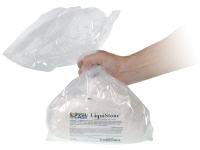LiquiStone™ /2,2 kg
Accu-Cast™ LiquiStone™ is an easy to use gypsum cement that can be cast into Accu-Cast™ alginate molds for reproducing human body parts for lifecasting. LiquiStone™ has a convenient mix ratio of 2 parts stone to
1 part water by volume and will have a working time of about 15 minutes. Castings can be demolded in about 3 hours. LiquiStone™ can be cast solid, or can be laid up by hand (thicker consistency required). Fully cured
castings can be machined, sanded, primed and painted.
Mix Ratio: 2 parts LiquiStone™ to 1part water by volume, or 2.3 parts LiquiStone™ to 1 part water by weight
Pot Life: 15 minutes - Demold time: 3 hours* - Full Cure: 24 hrs. - Color: White - Compressive Strength: 6000 psi (41.4 MPa)
Density, Wet: 1762 kg./m3 - Density, Dry: 1442 kg/m3 - % Maximum Expansion: 0.42%
*Depending on mass and water concentration. Data achieved under controlled laboratory conditions with freshly produced material, results may vary
|
|
Instructions
PROCESSING RECOMMENDATIONS
Safety - Wear safety glasses to minimize contamination risk. Use only in a well-ventilated area. Wear a NIOSH-approved N95 dust mask when processing powdered material.
WARNING: IRRITANT TO EYES & MUCOUS MEMBRANES. Do not get in eyes, or in mucous membranes. Do not take internally. Do not breatheparticulates.. Keep Out of Reach Of Children.
Because no two applications are quite the same, a small test application to determine suitability for your project is recommended if performance of this material is in question
MIXING LIQUISTONE™
Mix Ratio - The mix ratio for LiquiStone™is 2:1 (powder:water) by volume or 2.3:1(powder:water) by weight. Mix ratios can bevaried to achieve desired consistency. Lesswater produces a thicker consistency which is
ideal for hand layup molds. Too much water canweaken the physical strength of the LiquiStone™,lengthen curing time, and can result in water pooling on the surface of the casting which maycause unwanted runs of water flow along the surface of the finished reproduction.
Soaking the LiquiStone™ - Sift LiquiStone™ into water slowly and evenly. DO NOT drop large amounts of LiquiStone™ gypsum cement directly into water as proper soaking may not occur. LiquiStone™ must be fully
dispersed in water before mixing. Allow the LiquiStone™ to saturate in the water undisturbed for 2-3 minutes before mixing. Large batches may require longer soaking time.
Mixing LiquiStone™- LiquiStone™ gypsum cement can be mixed in the bag it comes in. Remove all jewelry and watches from hands before attempting to mix the material in the bag to prevent puncture
to the bag. Review the “mix-in-bag” mix technique video at www.accu-cast.us/handkit. Alternatively,you can mix the material using a turbine mixer (mechanical mixer) and portable drill. Drill mixing amounts
over 1.4 kg is recommended.
Pouring LiquiStone™ When pouring into a bucket mold, pour a small amount into the mold then pick up the mold and rotate it to allow the LiquiStone™ to penetrate the deepest recesses of the mold and push air out. Continue pouring into the mold to complete the pour.
CURING AND PERFORMANCE
Curing - Demold time is approximately 3 hours. Full cure in 24 hours. Amount of water in the mixture will affect cure time
Performance - Fully cured LiquiStone™ is a hard gypsum cement that can be machined, sanded, primed and painted.
PAINTING AND FINISHING
Repairing the casting - You can mix a small amount of LiquiStone™ with a very small amount of water to create a thick paste-like slurry that can be applied to your finished casting to repair imperfections on the surface.
Wet the area to be repaired first before applying a repair to avoid delamination.
Painting the Casting - It is generally recommended to wait at least 3 days at room temperature 23°C at 50% RH before priming and painting your LiquiStone™ castings.In cold weather or in high humid conditions, you may need to wait 4-5 days. Acrylic paints or spray enamel spray paints can be used. Apply paint or primer thinly to avoid filling in details.
